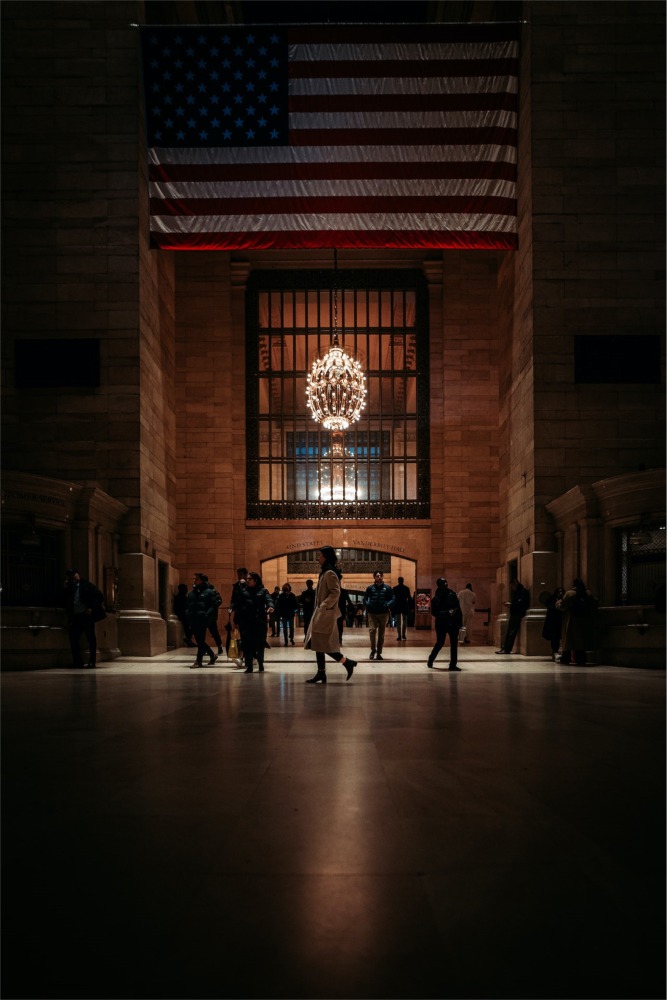Grand Central Terminal
Beaux Arts Chandelier
Home > New York State Photographs > New York > Grand Central Terminal Beaux Arts Chandelier

The main concourse of Grand Central Terminal was silent, almost cavernous, in the witching hour. The dazzling beauty of the beaux arts chandelier suspended beneath the star-spangled banner of Old Glory illuminated the south exit to 42nd Street with a warm, gentle light. Everywhere around it was darkness, shadows that seemed to collapse in on the main concourse like a velvet curtain pulled down over a stage.
But the chandelier held its own, a beacon of sorts, inviting the weary commuters to look up and take in its beauty, if only for a few moments of respite before continuing on their journey. Even in its silent state, it seemed to hum with a sense of importance, offering a brief moment of grace and beauty in the midst of the everyday hustle and bustle of the terminal.
The flag and the chandelier together, one above and one below, was a sight to behold. They were symbols of the grandeur and power of the city, the courage and strength of the nation, and the spirit of the people who traveled through this terminal day after day.
As the night progressed and the clock ticked closer to closing time, the main concourse was slowly filled with the sound of voices and the clatter of bags as people rushed to make their connections. But the chandelier still shone brightly, a reminder that beauty can be found even in the midst of chaos.
Grand Central Terminal
Grand Central Terminal, often simply referred to as Grand Central, is a historic transportation hub located in the heart of Manhattan, New York City. It is one of the city's most iconic and recognizable landmarks, renowned for its stunning Beaux-Arts architecture, intricate details, and significance in both transportation and cultural history.
Here are some key points about Grand Central Terminal:
History and Construction
Grand Central Terminal was conceived as a replacement for the older Grand Central Station which in turn, was a reconstruction of the original Grand Central Depot which had become inadequate for the growing transportation needs of New York City. Construction began in 1903, and the terminal officially opened to the public in 1913.
Architectural Marvel
The terminal's architecture was designed by the architectural firms Reed and Stem, and Warren and Wetmore. Its design is characterized by the Beaux-Arts style, which emphasizes grandeur, symmetry, and ornate detailing. The exterior features a monumental façade with large windows, sculptures, and intricate decorations.
Main Concourse
The Main Concourse is the most iconic feature of the Grand Central Terminal. It is a vast, cathedral-like space with a stunning celestial mural on the ceiling known as the "Grand Central Celestial Ceiling." The mural depicts constellations and stars on a green background and has become one of the terminal's most recognizable elements.
Information Booth and Clock
The iconic information booth is in the center of the Main Concourse, topped by a four-faced clock made from opalescent glass (opal glass). This clock is a popular meeting spot for commuters and tourists alike.
Transportation Hub
Grand Central Terminal serves as a major transportation hub for New York City. It primarily serves the Metro-North Railroad, providing train services to the northern suburbs of New York and Connecticut. The terminal also has connections to the New York City Subway, making it an essential point of transit for thousands of daily commuters.
Shops and Dining
Grand Central Terminal is not just a transportation hub; it's also a shopping and dining destination. The terminal houses numerous shops, boutiques, and restaurants, offering a variety of goods and cuisine to both commuters and visitors.
Restoration and Preservation
In the late 20th century, Grand Central Terminal faced the threat of demolition due to changing transportation needs. However, a successful preservation campaign led to the terminal being placed on the National Register of Historic Places in 1976. A comprehensive restoration effort was undertaken to bring the terminal back to its original glory.
Cultural Significance
Grand Central Terminal has appeared in numerous movies, TV shows, and books, making it a symbol of New York City in popular culture. Its beauty and grandeur have also made it a popular spot for tourists, photographers, and artists.
Grand Central Terminal stands as a testament to the architectural and engineering achievements of its time while remaining a vital part of New York City's transportation network. Its blend of historic significance, architectural beauty, and functional importance continues to make it a beloved and iconic landmark.


